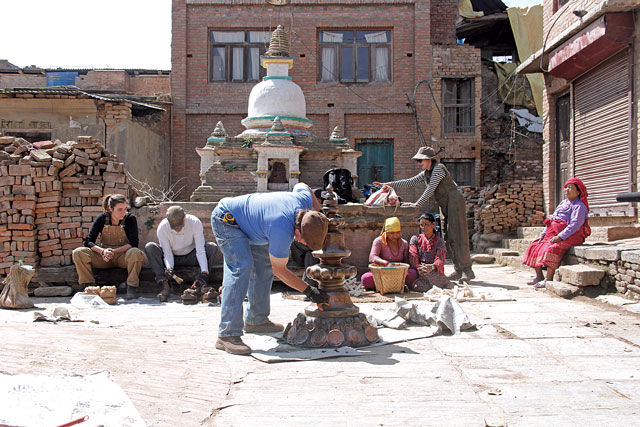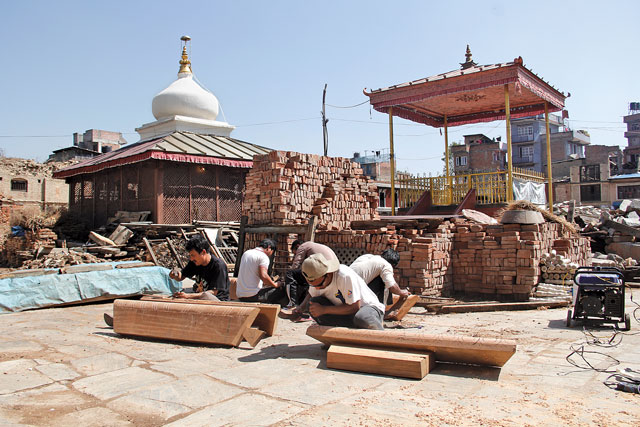One of the most picturesque little towns in the Kathmandu valley, Bungamati was also one of the most devastated during the great quake.
 When I first came to Nepal after the earthquake, I didn’t feel the destruction, in the sense that the people were so alive and enthusiastic,” exclaimed David Best, an artist. Along with his team, he is building a not-so-temporary replica of a stupa, 20 feet tall, from remainder pieces of wood bought from the local community. The stupa is going to be exhibited at the ‘Nature & Culture’ exhibition in Nepal Academy soon, and he hopes it will be brought back here to Bungamati and placed somewhere as a focal point as a memento of the mighty quake, and the resulting damages and losses it caused.
When I first came to Nepal after the earthquake, I didn’t feel the destruction, in the sense that the people were so alive and enthusiastic,” exclaimed David Best, an artist. Along with his team, he is building a not-so-temporary replica of a stupa, 20 feet tall, from remainder pieces of wood bought from the local community. The stupa is going to be exhibited at the ‘Nature & Culture’ exhibition in Nepal Academy soon, and he hopes it will be brought back here to Bungamati and placed somewhere as a focal point as a memento of the mighty quake, and the resulting damages and losses it caused.
 Bungamati is definitely starting to get back to life now. The community is getting back to its daily life. The majority of the locals are skilled woodcarvers, making fine wood carvings and souvenirs, which they sell to tourists. In the aftermath of the devastating quake, what is important is the spirit and enthusiasm of the people; the will to grow back again, something that almost got knocked out. For the record, Bungamati was one of the most devastated places in Kathmandu Valley.
Bungamati is definitely starting to get back to life now. The community is getting back to its daily life. The majority of the locals are skilled woodcarvers, making fine wood carvings and souvenirs, which they sell to tourists. In the aftermath of the devastating quake, what is important is the spirit and enthusiasm of the people; the will to grow back again, something that almost got knocked out. For the record, Bungamati was one of the most devastated places in Kathmandu Valley.
Humble projects like David Best’s, where the community can participate, put in whatever it can, and get something out of it, are what are needed today. They give people something to look forward to. That the project bought leftover wood from the community, and recruited around 20 locals to carve, paint, and build the stupa, means that it has put skill and money to good use. It is even better in the sense that it has got the community engaged, spreading awareness about the state of the place, and advertising the skills of locals among the
worldwide community.
For now, people here need the community restored, rather than anything else. The houses, water system, and electricity supply need to be rebuilt again. Temples, it might seem, are the last things they need at the moment. However, the reverse applies here, as well. It is a fact that Machhindranath Temple is not only the center of attraction of Bungamati, but life itself revolves around it. People believe that once the temple is restored, their lives will go back to normal again; everything revolves around the temple here.
But, then, it’s hard for a community go beyond the policies set up by the government, whose inability to work on schedule has severely slowed down the renovation of Bungamati. Strolling down its alleys, I saw flex board prints of the renovation module proposed by the municipality, how the place will look like once work gets completed. Absolutely splendid. In fact, the renovation work was inaugurated by the prime minister himself on Magh 2, 2072.
But locals are sad, and they testify that no progress has been made since. It’s quite unclear how the renovation project is going to get funded, considering that the government has decided to provide only a maximum of two lakh rupees per house. It seems that organizations trying to work for the project haven’t yet come to an understanding with the government. Also, it wouldn’t be wise to ignore complications due to the recent conversion of VDCs into municipalities, which include nearby villages like Dukuchap and Champi, where even basic infrastructure is lacking.
For sure, most people here are unable to build the houses as proposed due to the financial complexity. And, even for those who can and are willing to build their houses themselves, the government has yet to begin approving the required engineering drawings. Locals say the government is still carrying out record keeping of the damages from the quake. It was sad for me to see the numerous damaged houses, and small temporary settlements made up of ply, bamboo, and tin sheets. Danish People’s Aid, students of Kathmandu University, and a few other organizations were generous enough to build them, about whom the people here reminisce as life savers. Danish People’s Aid, alone, built around 300, and students of Kathmandu University made around one hundred. People definitely are trying to grow back again. Small eateries serving tea and bara, carpentry workshops here and there, and souvenir shops are keeping alive what remains
of Bungamati.
Like projects where people are happy to move rubble and deposit them at appropriate spots, support of the same nature is needed here: payment for labor, with ownership of whatever is renovated. This might just be the appropriate project type for both the supporters and Bungamati locals. Without doubt, it will be an example if the Machhindranath Temple of Bungamati could be rebuilt this way. “The glorious temple, with its history of 1,528 years, should be rebuilt with up-to-date procedures and thorough quality checking,” emphasizes Kapil Bajracharya, wood expert at the Department of Archeology. “And, I believe the job can be done with the best craftsmen from Bungamati itself.” The synergy formed by community involvement, government support, and supporting groups would be ideal to rebuild and revive Bungamati.










